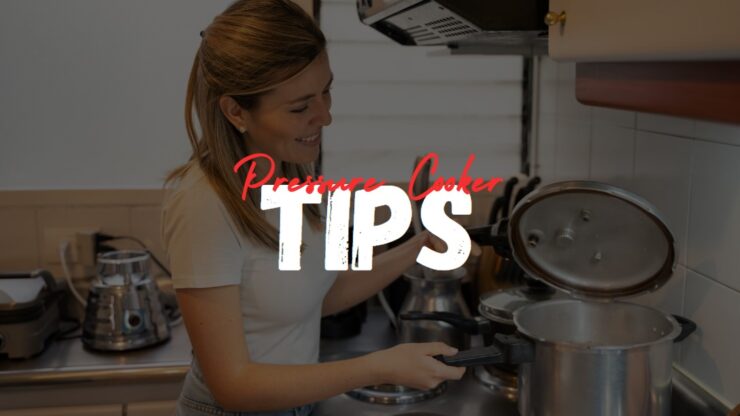Pressure cooking is a unique and quick method of cooking that requires special attention and care to prevent any burning or disasters in the kitchen. To master the art of pressure cooking, you need to understand its science and principles thoroughly and execute them with precision.
Common Reasons for Burning on the Bottom
Pressure cooker burning on the bottom can happen due to a variety of reasons. Inability to maintain pressure, cooking on high heat, adding insufficient water, cooking food without stirring, and unsuitable utensils can contribute to it. To prevent burning, check if the pressure cooker can hold the pressure properly, use the right amount of water, set the burner to the right temperature, stir the ingredients while cooking, and use a compatible cooking vessel.
Moreover, avoid leaving the pressure cooker along with high heat, letting the food overcook, and adding a thickener before cooking. These simple precautions can save you from burning your dish and wasting your time and ingredients. If you want to avoid the disappointment of not enjoying your meal, always follow the instructions and check the cooker’s manual before cooking. With a bit of attention, you can easily prevent burning on the bottom of your pressure cooker and cook delicious meals in no time.
Temperature too High
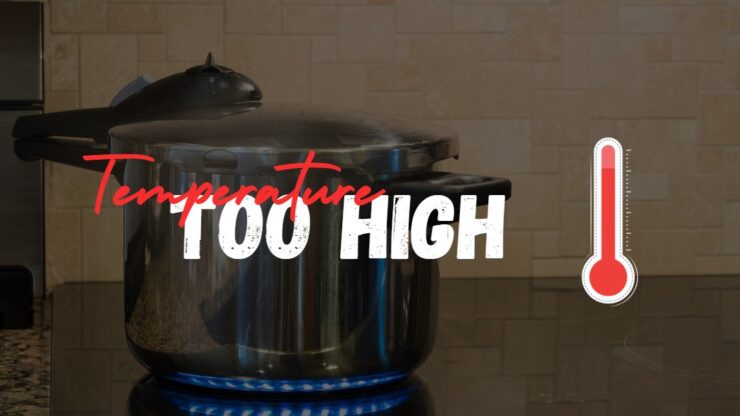
Excessively heated temperatures can often lead to burning on the underside of your food. This occurs when the thermal intensity exceeds what your dish can handle causing it to char and burn. Continued high-temperature cooking can result in significant damage and cause a fire hazard. However, it’s crucial to understand that high heat is required for some dishes such as searing steak or vegetables.
To prevent burning, use a cast-iron skillet or any other pan with good heat retention qualities rather than a thin one. It’s also important not to crowd your pan as this can decrease the heat efficiency and may lead to some areas of the dish being overcooked while others remain undercooked. So, keep the cooking portions small and cook in batches if you have larger items. Always remember that burnt food is not only harmful but also tastes unpleasant.
To avoid ruining meals with an acrid taste and texture, it’s important to monitor temperatures vigilantly throughout cooking. Take measures to prevent overheating and follow recommended cook times carefully for best results.
Insufficient Liquid
The issue of not having ample liquid can cause burning on the lower side of the cooker. It might seem simple, but it’s a common cooking mistake made by many. If you don’t have enough liquid in the cooking pot, it may lead to overheating and ultimately culminate in the scorching of food on the bottom. To avoid this situation, make sure to check before you start cooking if there is sufficient liquid. For some recipes, you can add a little bit of extra water to prevent burns.
When cooking pasta or rice, make sure that there is enough water present, so they are adequately boiled without sticking to the pan. A crucial point to note is that some foods like tomato sauces or sugar-containing items need a lot more care than standard recipes when it comes to being burnt on the base. Also, stirring regularly will help keep food from sticking and thereby avoiding scorching.
It’s essential to understand that even if your heat source is low and slow, there’s less chance of burning at minimal temperatures. Therefore, ensure that there is enough moisture content in your dish while cooking. According to Cook’s Illustrated magazine, “When meat browns or caramelizes in a frying pan with little fat or moisture instead of steaming, it gets stuck.”
Prepping the Pressure Cooker to Prevent Burning
Bottom burning in pressure cookers is a common but avoidable occurrence that can ruin a meal. To prevent it, proper prepping of the pressure cooker is crucial. Six essential steps to prevent bottom burning in pressure cookers:
- Make sure the cooking pot is clean and dry.
- Ensure there is enough liquid in the pot before starting to cook.
- Avoid overfilling the pot and abide by the manufacturer’s guidelines.
- Check the pot’s vent pipe and pressure release valve for blockages.
- Use the right burner size to avoid uneven heating and burning.
- Follow the recipe instructions and cooking duration to avoid overcooking and burning.
While proper prepping of the pressure cooker is essential, it is also relevant to use the right cooking method and ingredients. The cooker’s heating source should be adjusted and regulated, and cooking times and temperatures should be appropriately set, to avoid scorching or undercooking.
Cooking Techniques to Avoid Burning
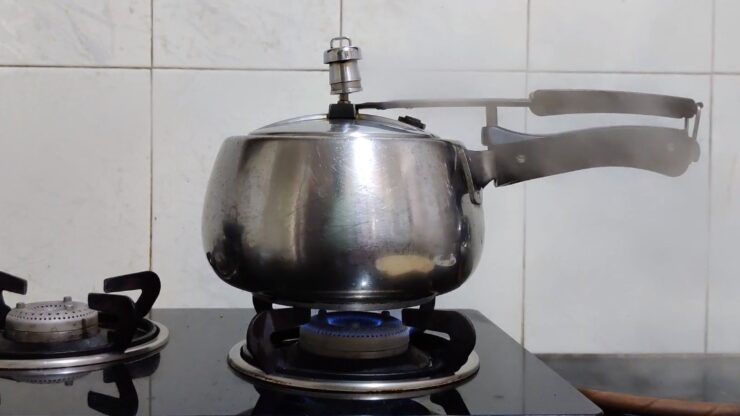
To avoid burning food while cooking, certain methods can be employed. These methods will help to ensure that your meals do not end up burnt, thus making them unsuitable for consumption. Below are six cooking techniques that can be used to prevent burning.
- Set The Right Temperature: Adjust the cooking temperature based on the type of food you are cooking to ensure that it does not cook too fast or too slowly. Use a cooking thermometer to monitor the temperature.
- Use The Right Amount Of Oil: Always use the right amount of oil while cooking. Too little of it will make the food stick to the pan, while too much of it will make the food greasy.
- Keep Stirring: Food should be stirred regularly while cooking to prevent it from sticking to the bottom of the pan.
- Add Liquid: Adding liquid while cooking can help to reduce the risk of burning. For example; while making sauce, wine or broth can be added to the recipe.
- Use Non-Stick Pans: Non-stick pans make it easier to cook without burning. These pans are coated with a non-stick substance that prevents food from sticking to the surface.
- Attention To Cooking Time: Pay close attention to cooking time, as this can also help to prevent burning. Once the cooking time has been reached, remove the food from the pan.
It is also important to note that the type of food being cooked will impact the cooking method to prevent burning. Additionally, it is crucial to keep the burner clean as leftover food on the stove can continue to cook, leaving burnt bits on the bottom of the pan. You do not want your family and guests to have a bad culinary experience. Last year I charred my stir fry when I enabled the burner on high heat and got distracted due to my kids. Ever since then, I have been employing these six cooking techniques to prevent burning.
Sautéing Ingredients First
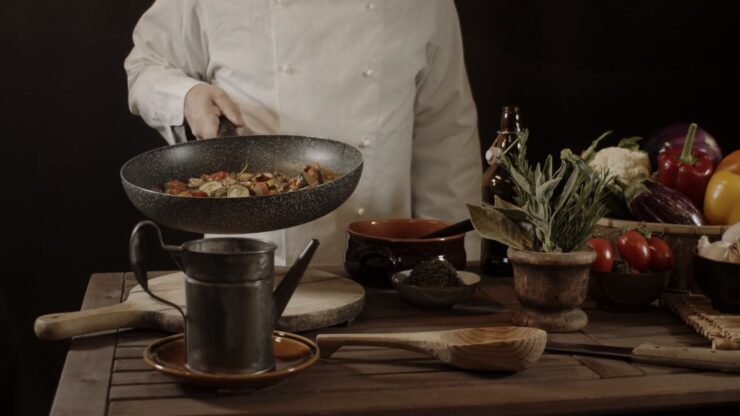
When cooking, it is crucial to avoid burning the ingredients. One popular technique to prevent this is by using the process of ‘pre-sautéing’. This method involves pre-cooking the ingredients before adding them to the final dish, ensuring that they don’t get overcooked or burnt. To sauté ingredients first:
- Heat your pan on high heat, preferably with a little bit of oil.
- Add your ingredients to the pan and allow them to cook quickly while stirring occasionally.
- Once all sides are browned and crispy, remove from heat and set aside.
- Use the same pan for the rest of your dish, adding additional ingredients as necessary.
- Add back the sautéed ingredients when close to finishing so they can reheat and mix well with other flavors in the dish.
It’s important to note that each ingredient may require different times for pre-sautéing. More delicate foods like spinach or mushrooms should only be cooked briefly, while sturdy vegetables like carrots may need longer times in the pan.
Natural Release Method
This cooking technique involves letting the pressure cooker release steam for a duration of time before opening the lid. Doing so prevents rapid depressurization and potential burning.
- Turn off the heat on your pressure cooker.
- Do not touch the steam release valve; let it do its job naturally.
- Set your timer to allow for natural pressure release according to recipe instructions.
- Beware of foamy foods spitting out – put a towel over the vent to prevent this if necessary.
- You’ll know when all the pressure is released when you no longer hear any hissing sounds or see steam escaping from the cooker.
- After ensuring that all pressure has escaped, carefully open your cooker by twisting or toggling off the lock mechanism while opening it away from yourself.
One unique detail about Natural Release Method is its convenience as you don’t need to handle hot cooking equipment nor worry about scalding liquids. However, be cautious and wait patiently until all pressure is released before unlocking or opening your appliance.
Troubleshooting Tips for Burnt Food in the Pressure Cooker
When food burns in a pressure cooker, it can be disappointing and frustrating. Here are some tips to avoid burnt food in the pressure cooker:
- Use Enough Liquid: Make sure you have enough liquid in the pressure cooker so that there is no chance of burning on the bottom.
- Avoid Overfilling: The pressure cooker should never be filled beyond its recommended maximum fill line. Overfilling can cause the food to burn.
- Adjust Heat: It is important to adjust the heat accordingly based on the recipe. Too high heat can cause the food to burn.
- Release Pressure: Always release the pressure completely before opening the pressure cooker lid. Otherwise, the steam can continue cooking the food, leading to burnt food.
- Check Seals: Ensure the pressure cooker’s seals are clean and functioning properly. Any leaks can dry out the liquid, causing the food to burn.
- Clean the Bottom: Regularly clean the bottom of the pressure cooker to avoid burnt food and stains.
It is essential to keep these tips in mind to prevent burnt food in a pressure cooker, creating a smooth cooking experience. Excessive heat can be one of the leading causes of burnt food in a pressure cooker. It is essential to learn how to monitor heat and cook according to the recipe’s instructions.
Letting the Pot Cool Down
After cooking in a pressure cooker, it is necessary to wait for the pot to reach normal temperature before opening it. Not allowing the pot to cool can lead to burnt food due to an increase in heat. To let the pressure cooker’s temperature reduce naturally, switch off the heat source and do not remove the lid immediately after cooking. This helps release steam naturally, helping prevent burnt food.
Additionally, running cold water on its surface or immersing it in cool water can help bring down its temperature quickly. It is essential to remember that releasing pressure from the pressure cooker incorrectly can cause burns and leaks. Use only manual release methods per manufacturer instructions. Another important aspect of preventing burnt food in a pressure cooker is ensuring enough liquid during cooking.
Too little liquid may result in overheating of the pot and lead to burnt food. According to experts at The Kitchn website, burnt food creates harmful chemicals like acrylamide, which can be hazardous if consumed regularly over time.
Cleaning the Pot Thoroughly
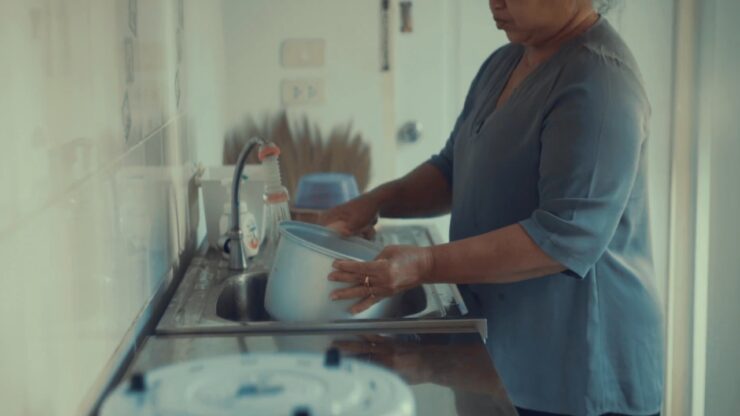
To ensure the pressure cooker pot is spotless, a thorough cleansing process is necessary. Below are three steps to give your pot a comprehensive deep clean.
- Scrubbing the Pot – Using a soft scrub brush with warm water and dish soap, gently scour the bottom of your pressure cooker’s pan until it is free from any food remnants.
- Soaking in Baking Soda Mixture – Fill the pot with water then add half a cup of baking soda. Let this mixture sit for 2-3 hours or overnight, depending on how tough the burnt food stain is.
- Rinse Pot – After soaking with baking soda solution, rinse out any remaining residue using warm water and dry thoroughly before storing.
Cleaning your glass stove top is also important to maintain cleanliness and prevent any residue from transferring to the pressure cooker pot. Use a specialized glass stove top cleaner and a non-abrasive sponge to gently remove any stains or spills from the surface.
After these tips have been implemented, any burnt food remnants should be removed entirely from your pressure cooker pot.
Conclusion
To effectively prevent a pressure cooker from burning on the bottom, it is essential to understand the root cause of this issue. Overheating and lack of liquid are common culprits that can lead to burnt food and damaged cookware. To avoid this, always ensure there is enough liquid in the pot and monitor the temperature closely during cooking. Additionally, using a non-stick or ceramic-coated pot can also help reduce the risk of burning.
By following these tips, you can enjoy evenly cooked meals without any fear of burnt bottoms. For added safety, it is crucial to release the pressure properly before opening the lid. Failure to do so may result in hot steam escaping abruptly and causing injuries. Always read your pressure cooker’s manual for specific instructions on how to safely release pressure. It may take longer than expected, but it is worth taking the time to do it right.
Don’t let burnt bottoms ruin your meal experience! Follow these simple steps for safe and effective pressure cooking that guarantees delicious results every time. Taking care of your equipment means better performance and longevity, which ultimately leads to better value for money in the long run – don’t miss out on this opportunity!

